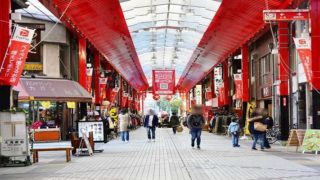Factory tours and “manufacturing” are somehow exciting.
The perfect facility for such people is Noritake Garden in Nagoya City, Aichi Prefecture, which is a complex facility for ceramics.
On the first and second floors of the Noritake Garden Craft Center, you can observe the manufacturing process of artisans and experience hand at painting
So, at the facility, both adults and children can enjoy.
Tour:Private Chartered Half Day Sightseeing Taxi Tour in Nagoya
The first and second floors of the Craft Center in Noritake Garden, where you can witness Noritake’s techniques and traditions, including the production process of ceramics.
Contents
Kraft Center in the Noritake Garden

Noritake Garden, a complex facility for ceramics has a “Kraft Center” that allows visitors to observe the manufacturing process.
On the first floor, they introduce the process of fabric production by pouring molding from “prototype production” to “glazed firing.”
On the second floor, you can see a variety of painting tasks, such as drawing methods and drawings by skilled craftsmen.
The “Picture Experience Corner (charged)” is also available, and it is a facility where both adults and children can enjoy the beauty of ceramics, such as knowing and creating them.
The 3rd and 4th floors are the Noritake Museum, which contains the Old Noritake.

Know about “Bone China” and the “Manufacturing Process”!


A type of porcelain, bone china, developed at the end of the 18th century in the United Kingdom, comes from the name of china, which uses ash of bovine bone as its raw material.
On the first floor of the Kraft Center, you can check the flow of “prototyping,” “molding,” “firing,” and “glazing” in the Bone China manufacturing process.
The following is a simple process.
First, clay was used to form a temporary mold using gypsum to make a prototype. From there, use molds are made.
Long stones, silica, kaolin, clay are finely divided, bone ash and water are added, and muddy mud is called “deisho”.
The mud is poured into a gypsum mold and “molded.
“Remove the mold and assemble the parts into a single shape.
Next, assemble, smooth the joints and adhesive surfaces, and bake the first time to bake (“Tightening”), and apply a layer of glaze (Yuyaku) to the surface with a spray to give gloss (“Glazed”). )) And then the second baking (“glazing”)
Artistic beauty of the “figurians,” such as the hero Perseus and the gold Killer whale(shachihoko)


Like the owl mentioned above, Noritake’s lineup includes not only tableware but also figurines called “figurian” figurines.
This approach to the artworks enhances Noritake’s formative power and feeds back into the tableware.
“Figurians” representing one scene of Perseus, the hero of the Greek myth, are full of excitement and pressure, so please check them.


In order to commemorate the friendly city alliance with Nanjing, China, the city of Nagoya produces fine ceramic gold shachihoko.
The city of Nagoya presented a male to celebrate the 25th anniversary of their friendship city relationship in 2003, and a female to celebrate the 30th anniversary of their friendship city relationship in 2008.
By the way, this Shachihoko is still white, but there is gold leaf on the surface of the gifted one.
A series of small discoveries! Repeated “firing”


This is followed by a “gold finish firing” in which gold lines are drawn on the handles of the cups and the edges of the plates.
Depending on the “painting” method, the number of firing times is increased.
In “gold finishing,” gold dyes are not used from the beginning.
Instead, after the firing process called “gold firing,” there are a number of small discoveries, such as bright gold colors, that make the manufacturing process fun.
With the long process described above, the finished products are sent to the dealer after a strict quality check using visual, tactile, and auditory skills.
firing: Heat to increase hardness and adjust color tone in the ceramic manufacturing process.
“artisan’s demonstration” and “painting experience corner”


On the second floor, you can see the craftsmen’s skills in front of you.
This is a rare opportunity to appreciate the technique not through glass, but in the same space where there is only a low partition.
Don’t miss the brightly colored platters and flower vases in the back of the room.
In some cases, you may be able to appreciate a very rare product.
When you see these manufacturing processes and the skills of the craftsmen, you may want to experience them.
There is also a “painting experience corner” on the second floor.
You can participate without a reservation and the fee starts at 1,800 yen.
Why not create your own unique piece of art with your child?
For those who are interested in trying to paint, the Noritake Artists Club offers classes in Aichi, Nagoya, and Akasaka, Tokyo.
Please check the link to the official site.
Overview of the first and second floors of Noritake Garden “Craft Center” in Nagoya City, Aichi Prefecture
After checking the manufacturing process of ceramics on the first and second floors of the Craft Center in Noritake Garden, let’s go to the Noritake Museum on the third and fourth floors where the early Noritake products “Old Noritake” are stored.
This ticket is the same as the Kraft Center, so you can see the ticket as it is.
With more knowledge, you can enjoy deeper and more noritake products.
That’s all of my introduction of the Kraft Center, a Noritake Garden in Nagoya City, Aichi Prefecture, where visitors can see the techniques and traditions of Noritake and experience painting.
















![11 Maid Cafe Ranking in Tokyo [Recommended even to beginners and ladies!]](https://jatrabridge.com/wp-content/uploads/slider/cache/11597c33ae53b47eb36a2f67968e635f/Maid-Cafe-Ranking-in-Tokyo2.3.jpg)





















